After sharing some of our favorite wildlife in Glacier Bay National Park, today’s post is all about the ice.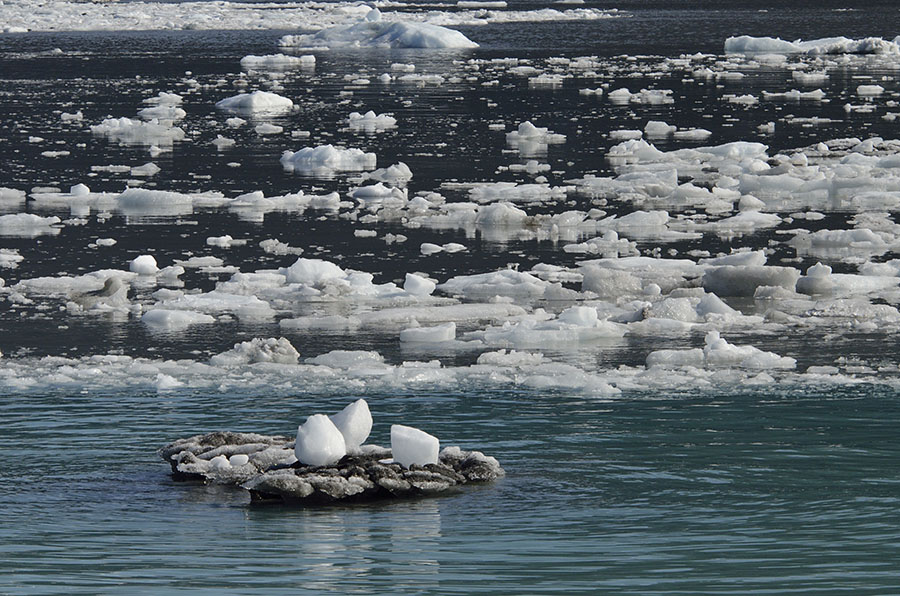
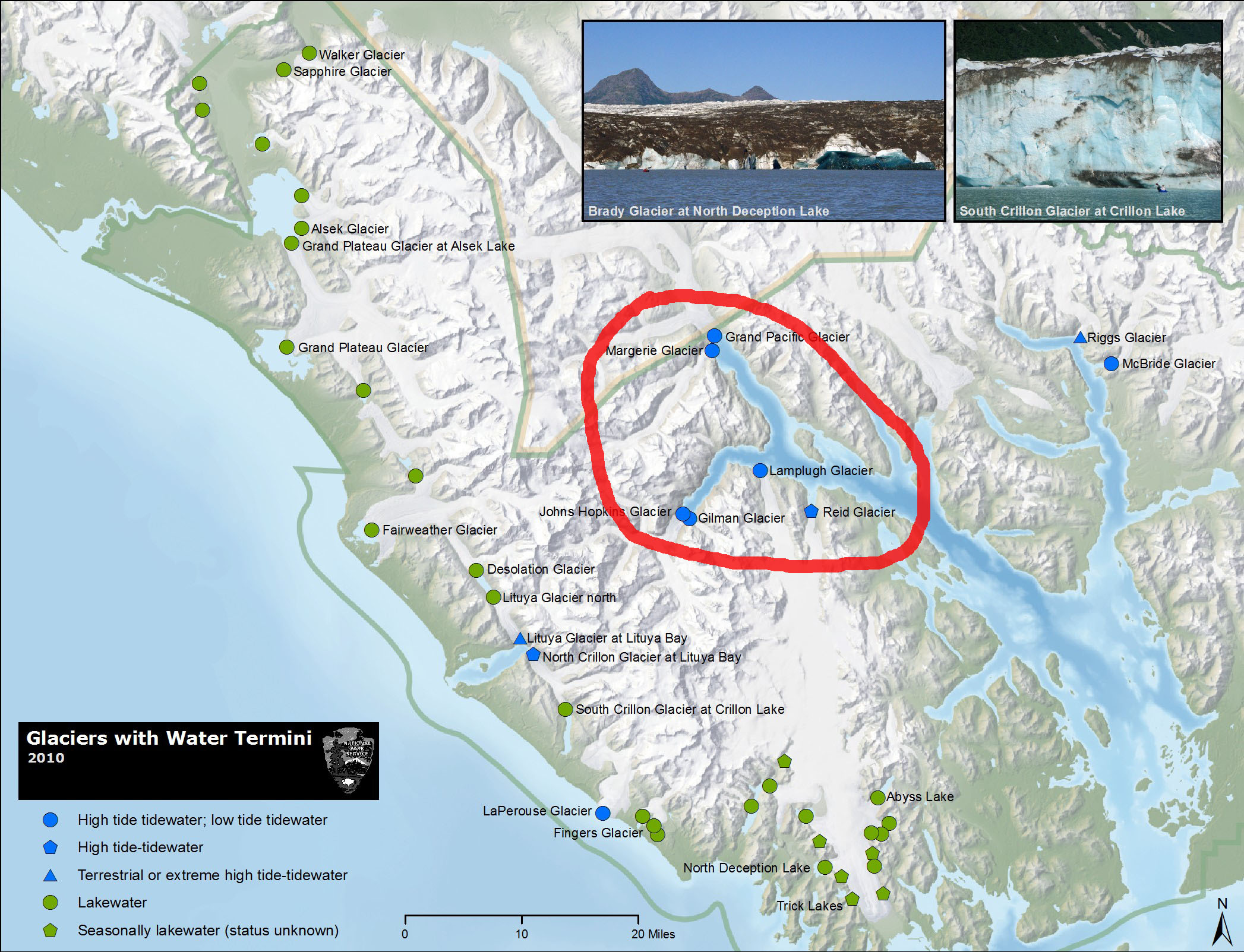 This map from the Park Service shows all the glaciers in the park that reach water – blue dots indicate salt water and green dots indicate fresh water lakes. The area circled in red is the west arm of the park that we explored this trip. There are hundreds of glaciers in the park that no longer reach water, called hanging glaciers like the Hoonah pictured here.
This map from the Park Service shows all the glaciers in the park that reach water – blue dots indicate salt water and green dots indicate fresh water lakes. The area circled in red is the west arm of the park that we explored this trip. There are hundreds of glaciers in the park that no longer reach water, called hanging glaciers like the Hoonah pictured here.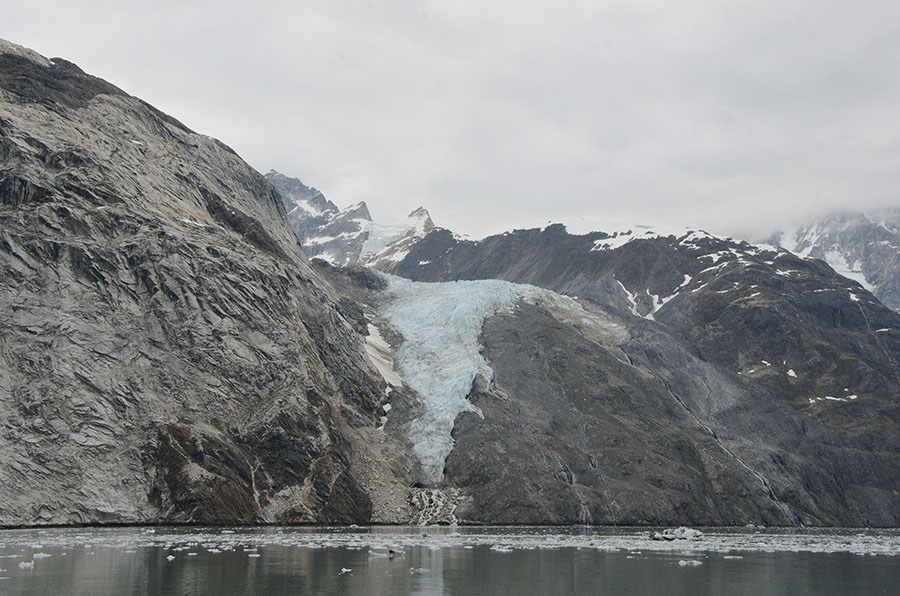
The first major glaciers we visited were the Margerie and Grand Pacific Glaciers – at the top of the red circle above. Note that the Grand Pacific glacier is now just across the border into Canada.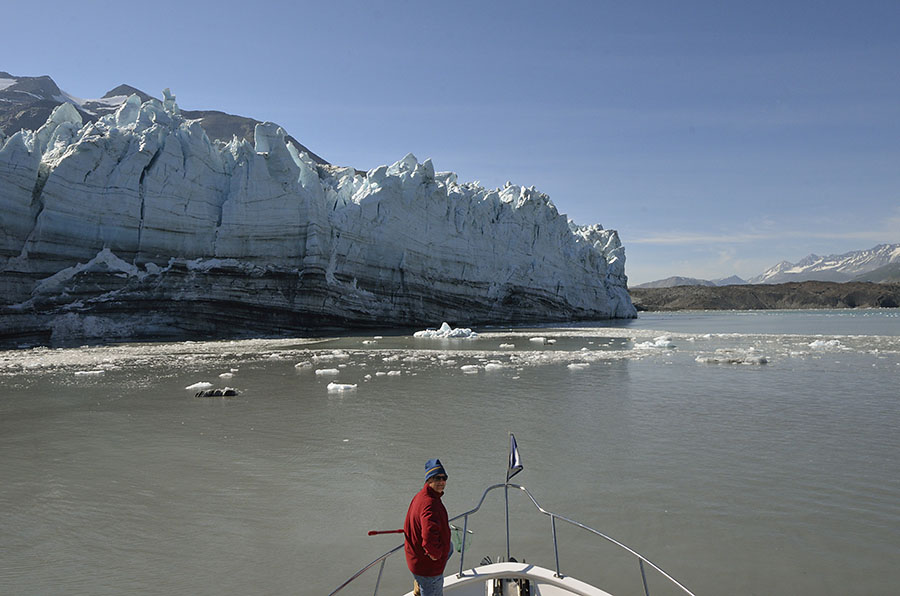 The Margerie is the obvious glacier on the left, and the low dark gray area to the right is the grit-covered Grand Pacific. About 250 years ago, during the Little Ice Age, the Grand Pacific covered both the east and west arms of the park, all the way down to Icy Strait.
The Margerie is the obvious glacier on the left, and the low dark gray area to the right is the grit-covered Grand Pacific. About 250 years ago, during the Little Ice Age, the Grand Pacific covered both the east and west arms of the park, all the way down to Icy Strait.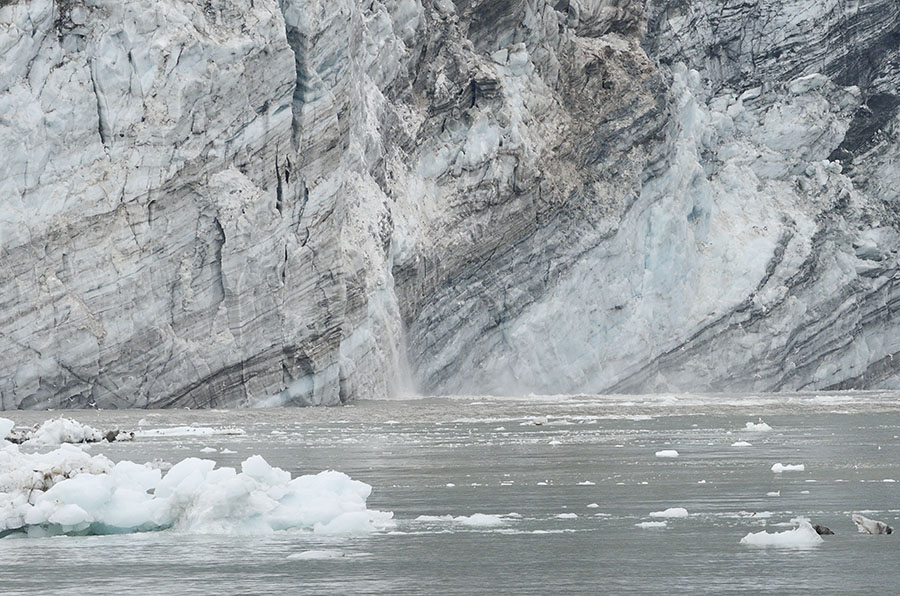 There’s something mesmerizing about the ice. Spires (called seracs) reach to the sky, chunks calve and fall into the water (or break off underwater and shoot to the surface), and the sound of cracking and rumbling remind us that the glacier is really a river of ice that’s constantly flowing down the mountains. As the mass of ice flows it picks up rocks, grinding and scouring the mountains underneath… embedding streaks of grit in the ice.
There’s something mesmerizing about the ice. Spires (called seracs) reach to the sky, chunks calve and fall into the water (or break off underwater and shoot to the surface), and the sound of cracking and rumbling remind us that the glacier is really a river of ice that’s constantly flowing down the mountains. As the mass of ice flows it picks up rocks, grinding and scouring the mountains underneath… embedding streaks of grit in the ice.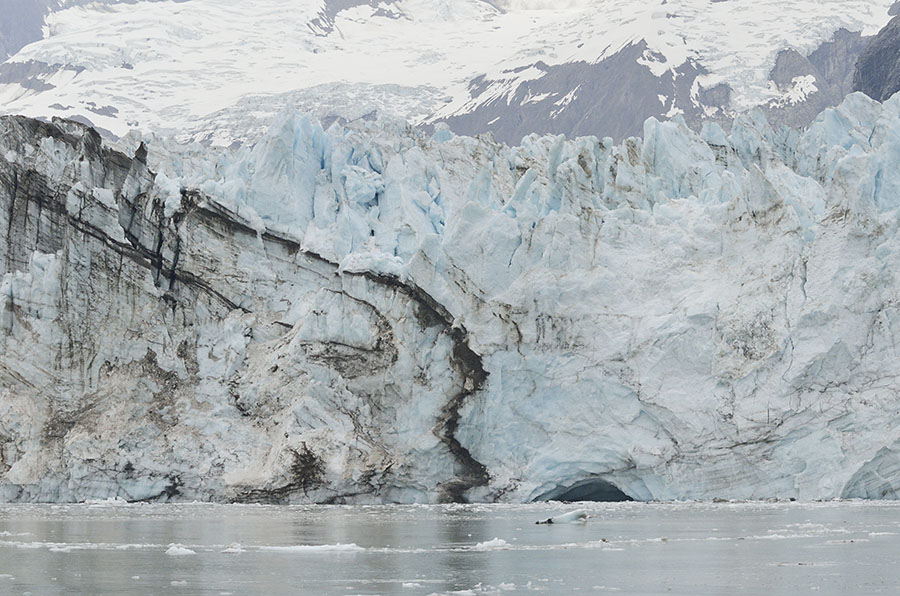 Ice with air trapped in it looks white, but ice under pressure turns clear or even blue – an almost fake-looking turquoise color. The blue ice is so compressed that it absorbs all the colors of the spectrum except blue, which it reflects.
Ice with air trapped in it looks white, but ice under pressure turns clear or even blue – an almost fake-looking turquoise color. The blue ice is so compressed that it absorbs all the colors of the spectrum except blue, which it reflects.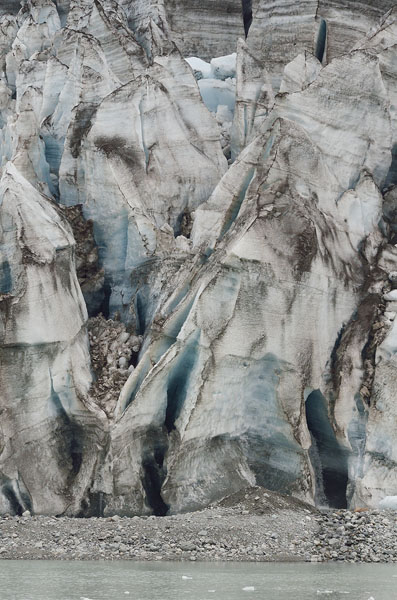 We think the most dramatic glacier in the bay is the Johns Hopkins glacier, and we were lucky that the inlet to it was pretty clear of ice so we were able to get fairly close. The grand view of it is what I love best though – with the rugged mountains behind.
We think the most dramatic glacier in the bay is the Johns Hopkins glacier, and we were lucky that the inlet to it was pretty clear of ice so we were able to get fairly close. The grand view of it is what I love best though – with the rugged mountains behind.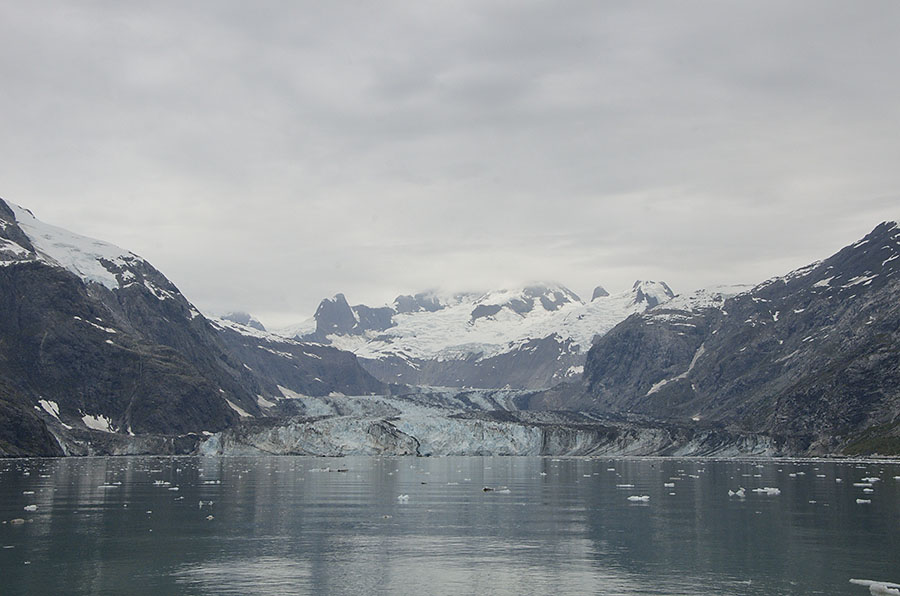 It’s difficult to grasp the scale of these glaciers, as well as their age and their power. Standing before them, feeling the cold wind whipping down from the peaks where they begin, hearing their cracking and watching ice calve into the water only hints at what these glaciers are all about.
It’s difficult to grasp the scale of these glaciers, as well as their age and their power. Standing before them, feeling the cold wind whipping down from the peaks where they begin, hearing their cracking and watching ice calve into the water only hints at what these glaciers are all about.
Sometimes we can get to the side of a glacier and touch it or even climb on it, and that’s the case with the Reid Glacier.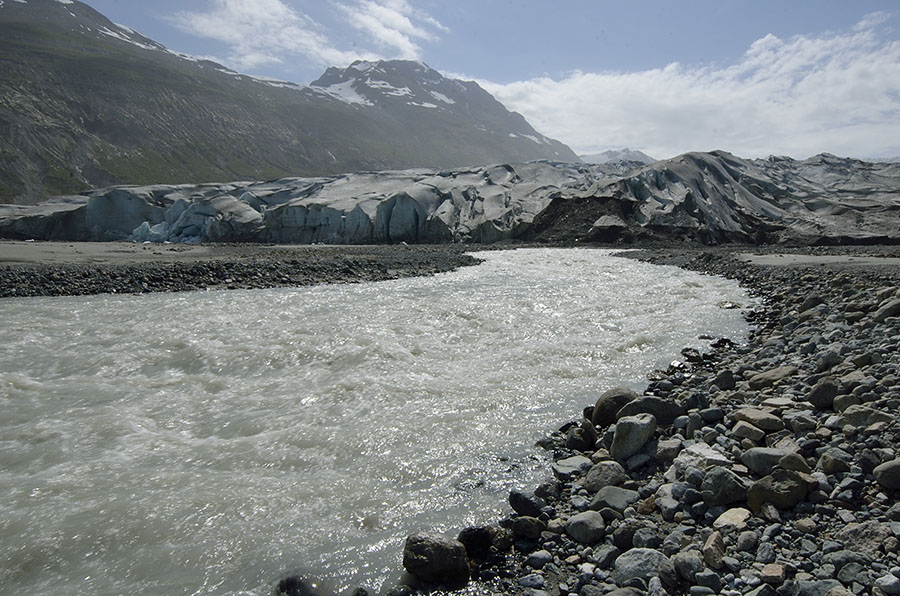 We can anchor in the basin that was formed by the Reid when it was larger, and take the dinghy to the shoreline near the face. This rushing river is melt water coming from underneath the glacier.
We can anchor in the basin that was formed by the Reid when it was larger, and take the dinghy to the shoreline near the face. This rushing river is melt water coming from underneath the glacier.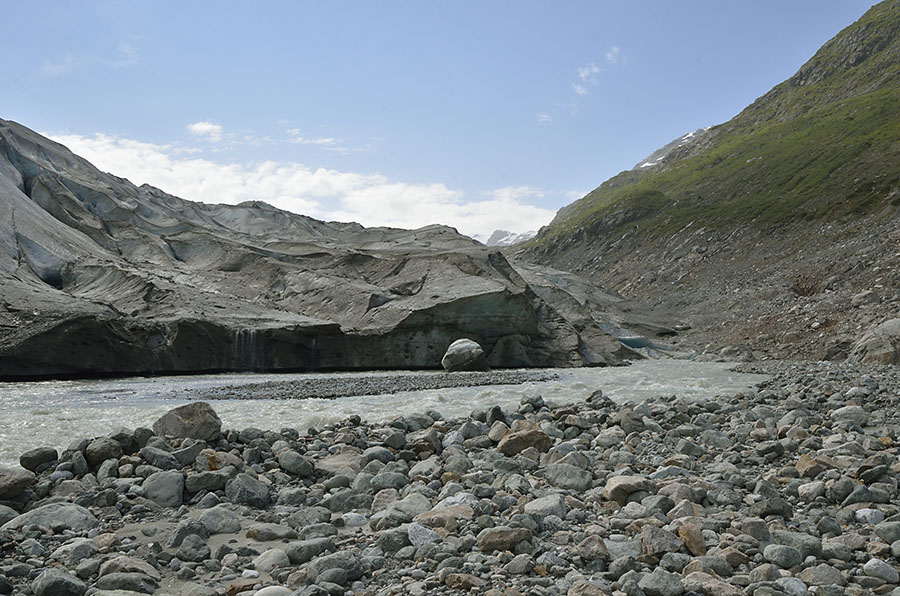 By hiking along the water’s edge we can reach the side of the glacier and get a better view of the alien landscapes on top.
By hiking along the water’s edge we can reach the side of the glacier and get a better view of the alien landscapes on top. 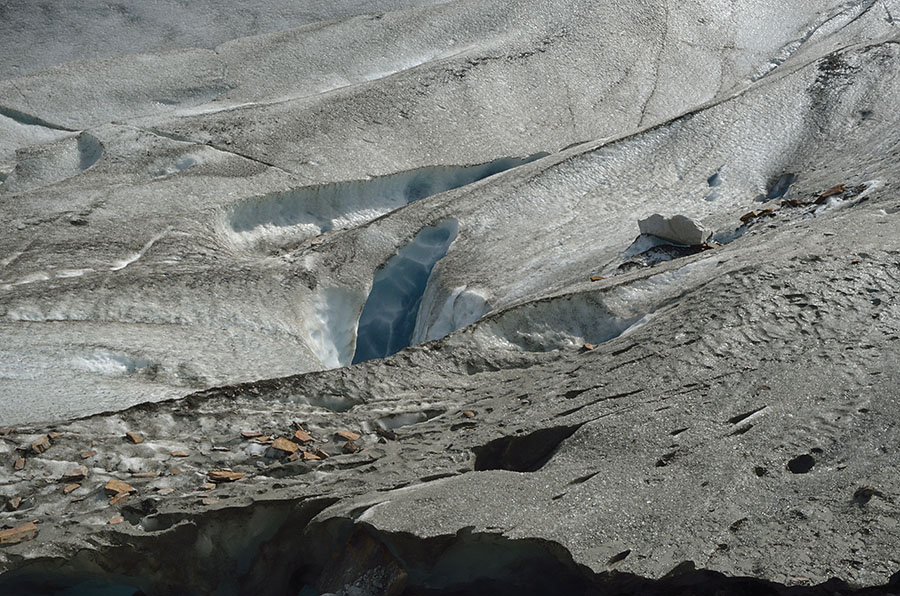
Looking back towards the entrance to Reid Inlet you can really see how the glacier scoured the landscape, though some wildflowers and willow are beginning to establish themselves, paving the way for an eventual forest.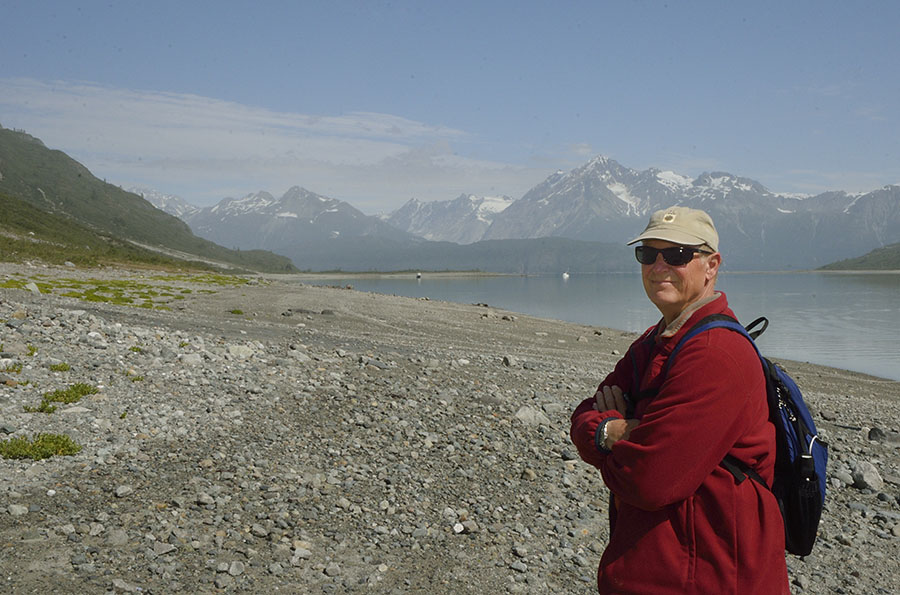 We had a little uh-oh moment when we hiked back to the dinghy. Normally Jim is ridiculous about setting the dinghy anchor so high up on shore that it would take a Biblical flood to cover it. This time he mis-judged a bit…
We had a little uh-oh moment when we hiked back to the dinghy. Normally Jim is ridiculous about setting the dinghy anchor so high up on shore that it would take a Biblical flood to cover it. This time he mis-judged a bit…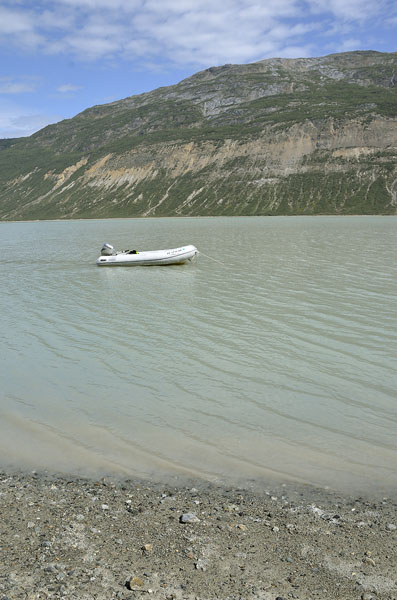 We had a good laugh about it, and the good news is that the tide was starting to fall so we wouldn’t have more than about an hour to wait… but it was also getting late in the day and we hadn’t had lunch yet! We suspected the anchor line was caught on a rock, but the opaque water made it impossible to guess where it was. There was another boat anchored near us, and it turns out that we have mutual boating friends. We spotted them out in their dinghy so we waved them over and they pulled up the anchor for us. Small world! But the little plover who had escorted us along the beach was not impressed.
We had a good laugh about it, and the good news is that the tide was starting to fall so we wouldn’t have more than about an hour to wait… but it was also getting late in the day and we hadn’t had lunch yet! We suspected the anchor line was caught on a rock, but the opaque water made it impossible to guess where it was. There was another boat anchored near us, and it turns out that we have mutual boating friends. We spotted them out in their dinghy so we waved them over and they pulled up the anchor for us. Small world! But the little plover who had escorted us along the beach was not impressed.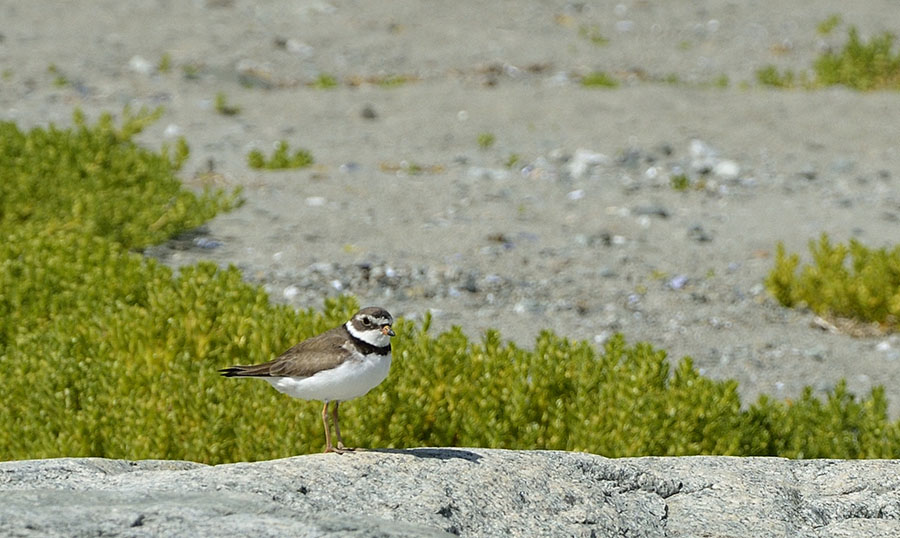
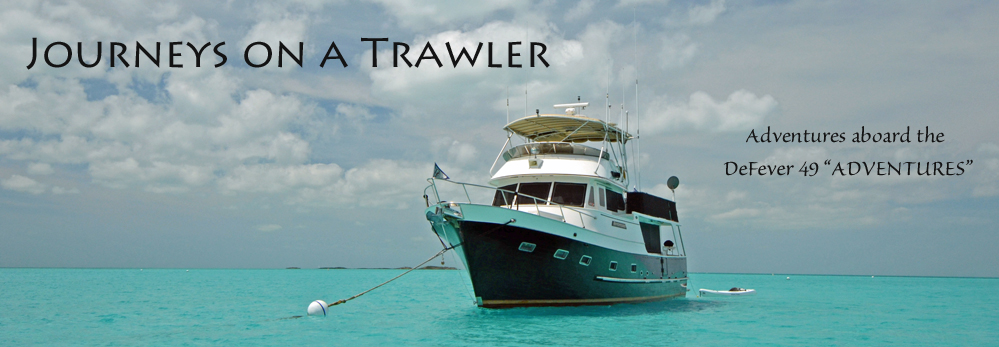
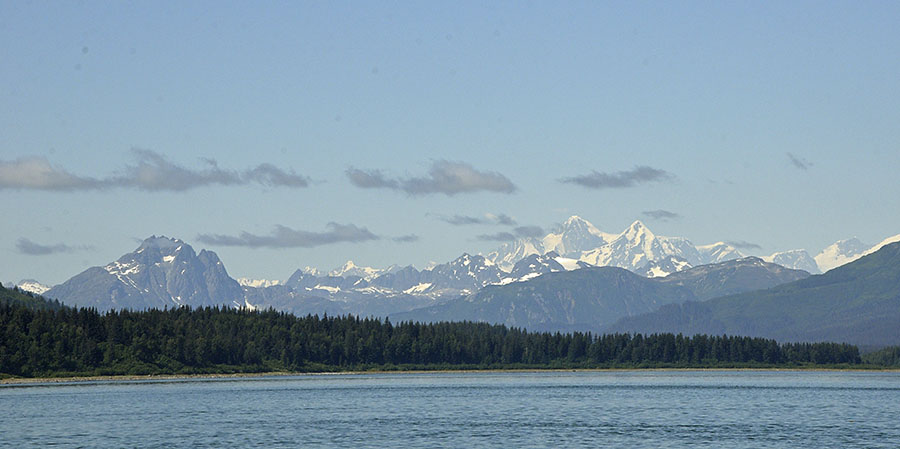 The park has many moods depending on the weather – shy and mysterious when it’s overcast and misty, or bright and brash when the sky is clear and you can see 15,325′ tall Mount Fairweather and the other distant mountains on the ocean coast. Regardless of the weather, we love the park for its density and variety of wildlife. We can see the same animals in other parts of southeast Alaska, but not as many of nearly everything in one place.
The park has many moods depending on the weather – shy and mysterious when it’s overcast and misty, or bright and brash when the sky is clear and you can see 15,325′ tall Mount Fairweather and the other distant mountains on the ocean coast. Regardless of the weather, we love the park for its density and variety of wildlife. We can see the same animals in other parts of southeast Alaska, but not as many of nearly everything in one place.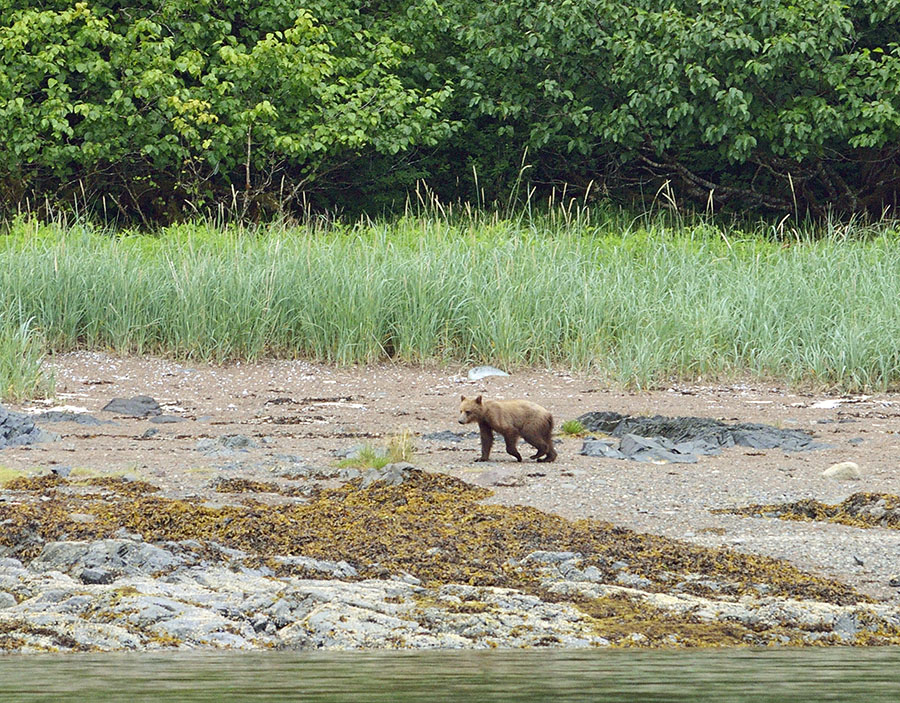 The park has brown bears (such as this sub-adult in the photo above) as well as black bears. We’ve even spotted a glacier bear – a rare gray-blue morph of the black bear. We’ve watched a brown bear sow teaching her cub to swim and we’ve watched a sow nursing her cubs. As this was our first visit to the park this year, we had to stop at the ranger station for a mandatory boater briefing. It’s always a treat to go ashore and stretch our legs, so we took a walk between the beach and the forest, not far from the park campground. We were talking and making noise when I spotted a sub-adult black bear just 30′ away, watching us from behind the trees.
The park has brown bears (such as this sub-adult in the photo above) as well as black bears. We’ve even spotted a glacier bear – a rare gray-blue morph of the black bear. We’ve watched a brown bear sow teaching her cub to swim and we’ve watched a sow nursing her cubs. As this was our first visit to the park this year, we had to stop at the ranger station for a mandatory boater briefing. It’s always a treat to go ashore and stretch our legs, so we took a walk between the beach and the forest, not far from the park campground. We were talking and making noise when I spotted a sub-adult black bear just 30′ away, watching us from behind the trees.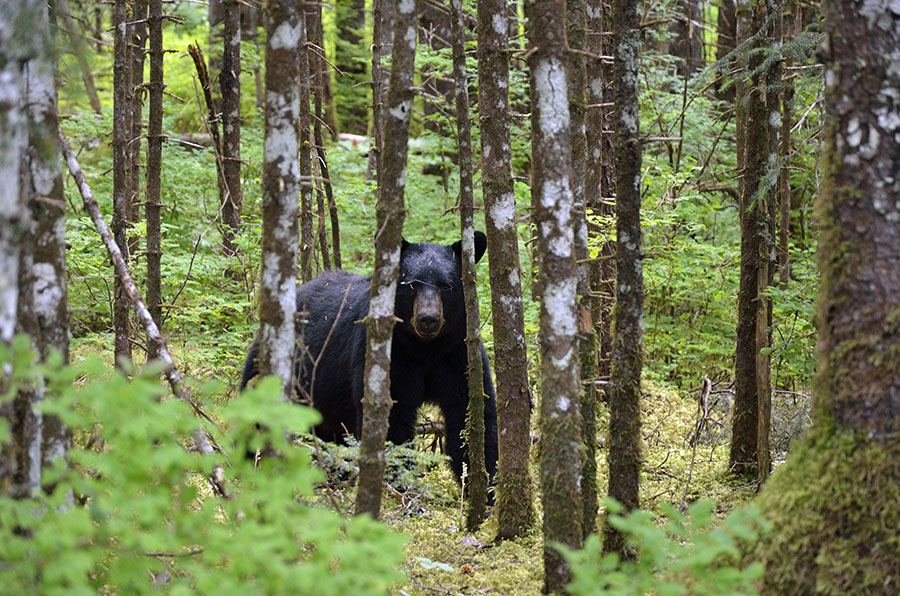 Usually a bear will avoid humans which is why it’s important to make human noises when you’re in bear country (and the majority of southeast Alaska is bear country). We were a little bothered by this bear – he should have been more afraid. We stood close together to appear larger, and we firmly told him to go away. He finally did, flattening his ears, huffing, and running deeper into the woods. We warned a few tourists that we saw on the forest trail, urging them to clap and say “Hey Bear!” as they walked, but most did not. Unfortunately stupidity on the part of humans usually results in a bad outcome for a bear.
Usually a bear will avoid humans which is why it’s important to make human noises when you’re in bear country (and the majority of southeast Alaska is bear country). We were a little bothered by this bear – he should have been more afraid. We stood close together to appear larger, and we firmly told him to go away. He finally did, flattening his ears, huffing, and running deeper into the woods. We warned a few tourists that we saw on the forest trail, urging them to clap and say “Hey Bear!” as they walked, but most did not. Unfortunately stupidity on the part of humans usually results in a bad outcome for a bear.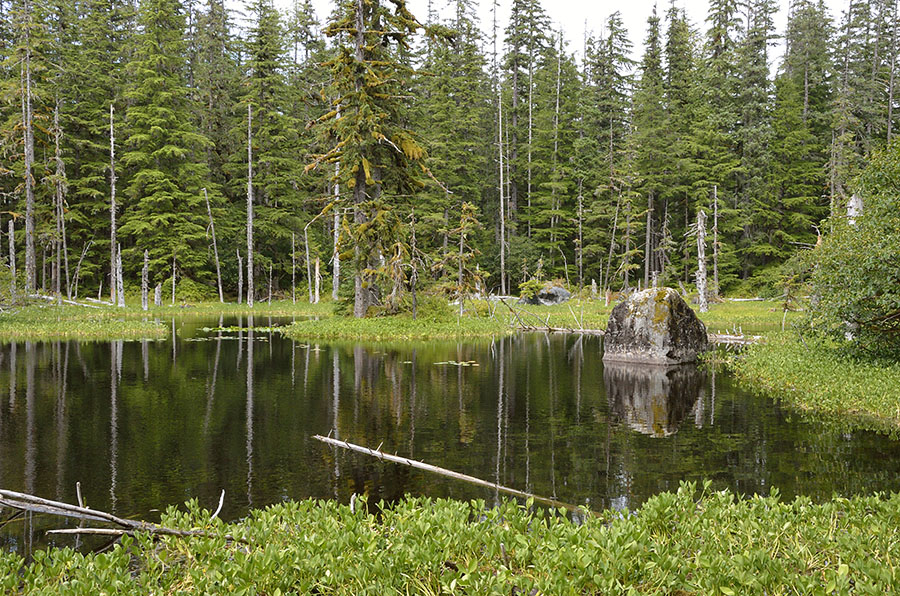 Whales were around, but not as plentiful as we’ve seen during other visits. We also heard reports of orca sightings on the radio, but always somewhere far from our location. Heading up to South Marble Island, we were guaranteed to see masses of Steller’s sea lions, puffins, pelagic cormorants, and nesting gulls and kittiwakes.
Whales were around, but not as plentiful as we’ve seen during other visits. We also heard reports of orca sightings on the radio, but always somewhere far from our location. Heading up to South Marble Island, we were guaranteed to see masses of Steller’s sea lions, puffins, pelagic cormorants, and nesting gulls and kittiwakes.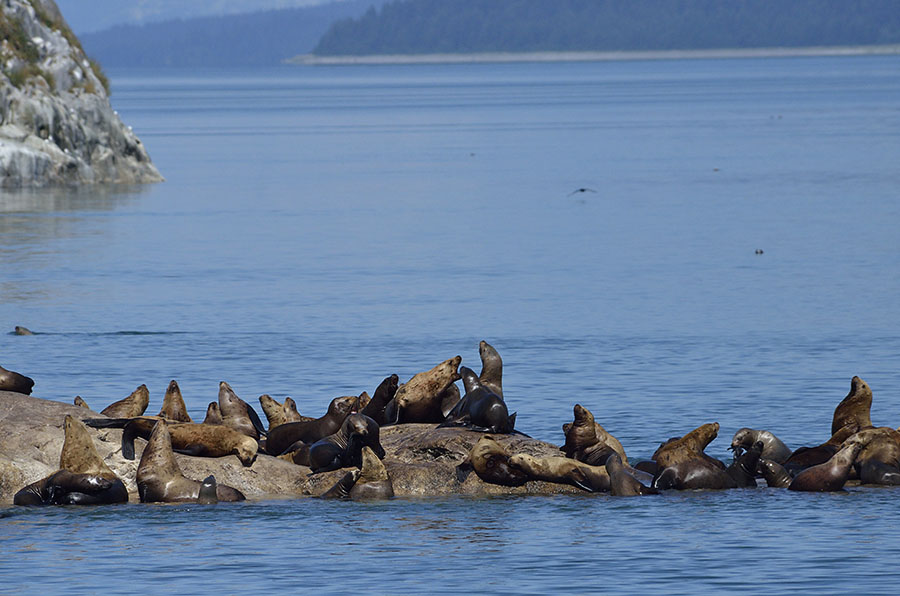 Sea lion haul-outs are great places to watch and listen. Many of the sea lions are trying to nap, but it doesn’t take much to get someone ticked off at someone else, and then the barks and groans rise to a din while the kerfuffle is sorted out. Things will settle down to softer groans for a few moments until it starts up somewhere else. There was a big bull we nicknamed Jabba The Hut since he looked just like the Star Wars character, but I love the young ones best – zipping around in little groups, cavorting and frolicking and generally showing off.
Sea lion haul-outs are great places to watch and listen. Many of the sea lions are trying to nap, but it doesn’t take much to get someone ticked off at someone else, and then the barks and groans rise to a din while the kerfuffle is sorted out. Things will settle down to softer groans for a few moments until it starts up somewhere else. There was a big bull we nicknamed Jabba The Hut since he looked just like the Star Wars character, but I love the young ones best – zipping around in little groups, cavorting and frolicking and generally showing off.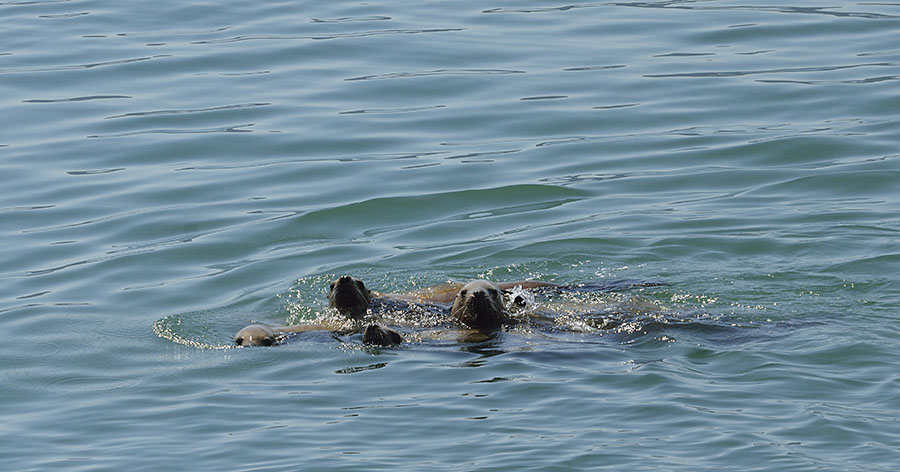 The puffins are some of my favorite birds, and we mostly see the tufted puffins here. They’re like blond surfers, shaking their heads to show off their golden tresses.
The puffins are some of my favorite birds, and we mostly see the tufted puffins here. They’re like blond surfers, shaking their heads to show off their golden tresses.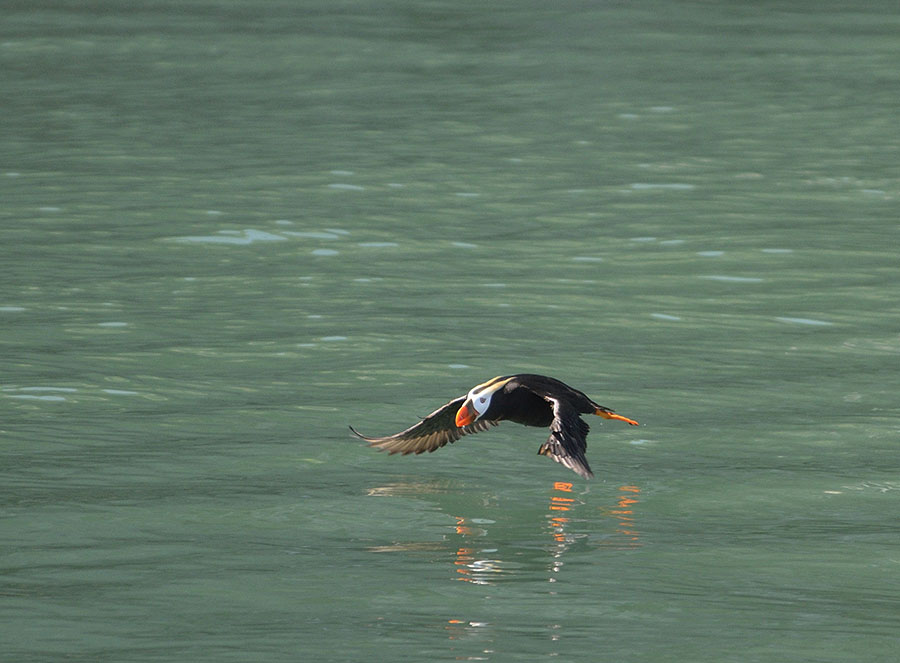
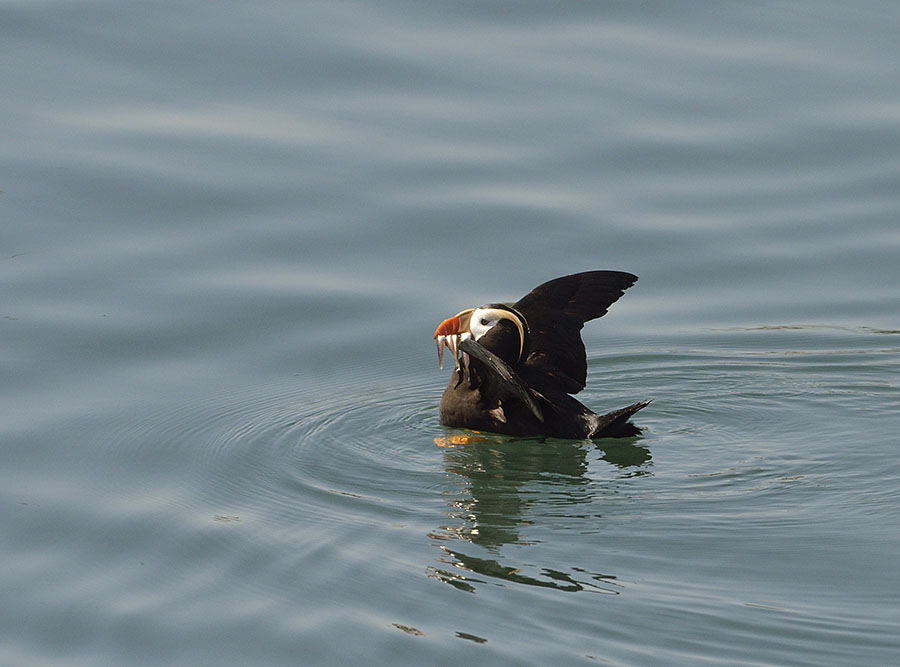 The puffins live at sea for most of the year, returning to make their nest in burrows on the side of the hills just for the summer.
The puffins live at sea for most of the year, returning to make their nest in burrows on the side of the hills just for the summer.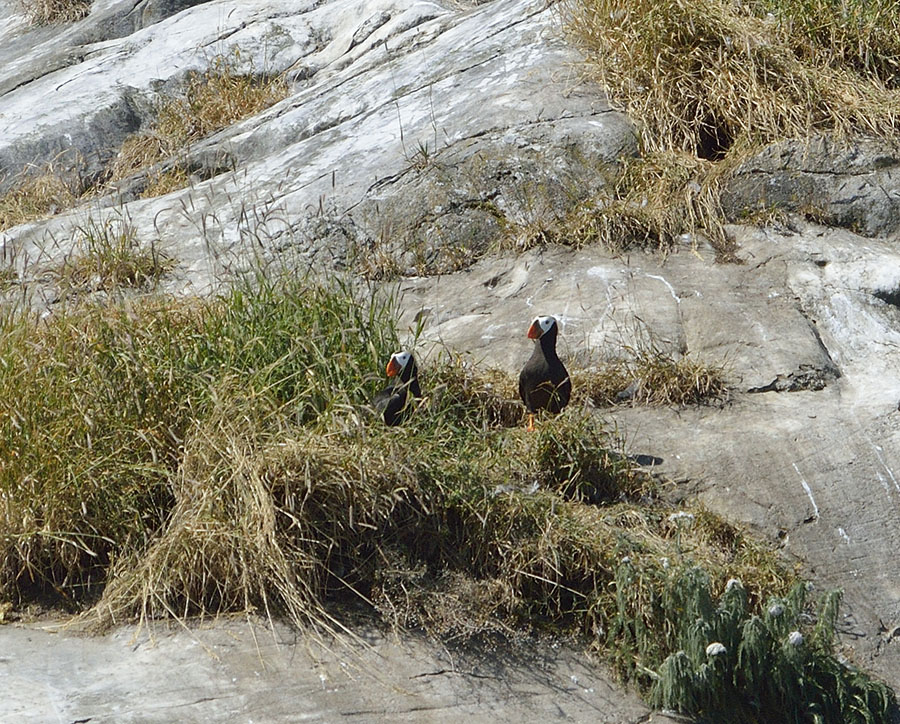 Pigeon guillemots, murres, murrelets, pelagic cormorants, gulls, kittiwakes, and the occasional horned puffin join ravens and eagles to make up the typical bird variety in the park.
Pigeon guillemots, murres, murrelets, pelagic cormorants, gulls, kittiwakes, and the occasional horned puffin join ravens and eagles to make up the typical bird variety in the park.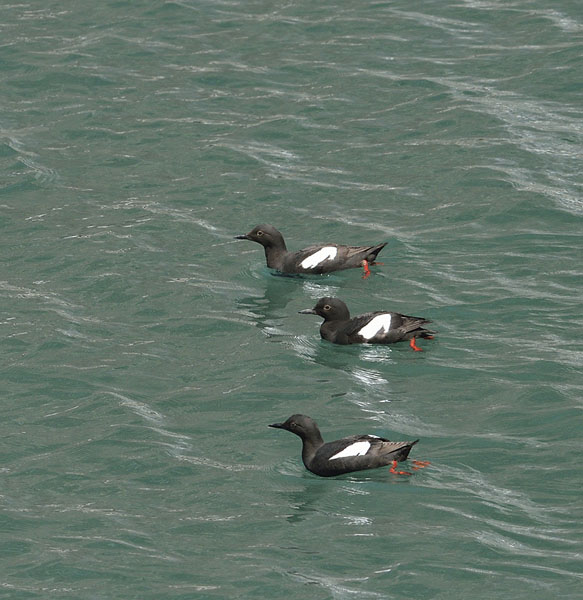
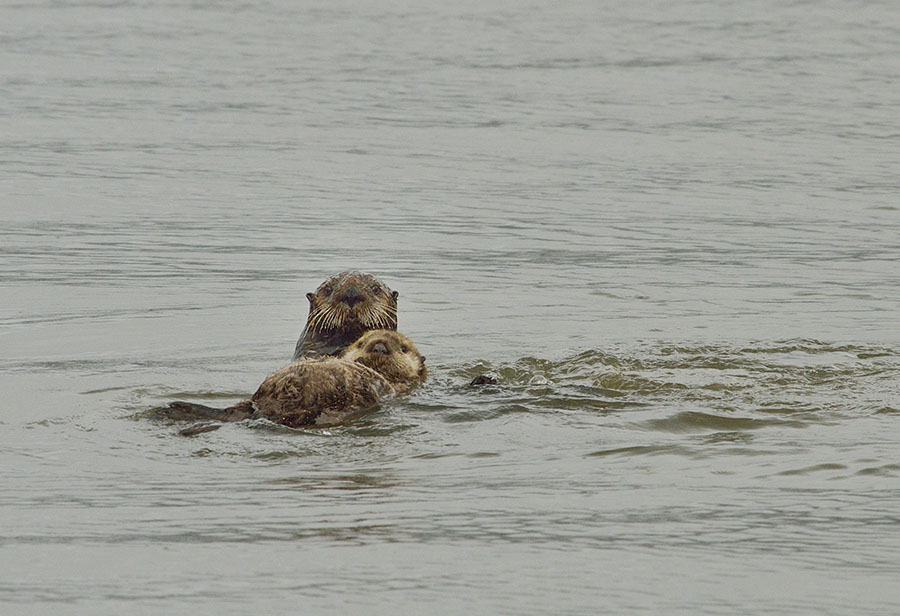
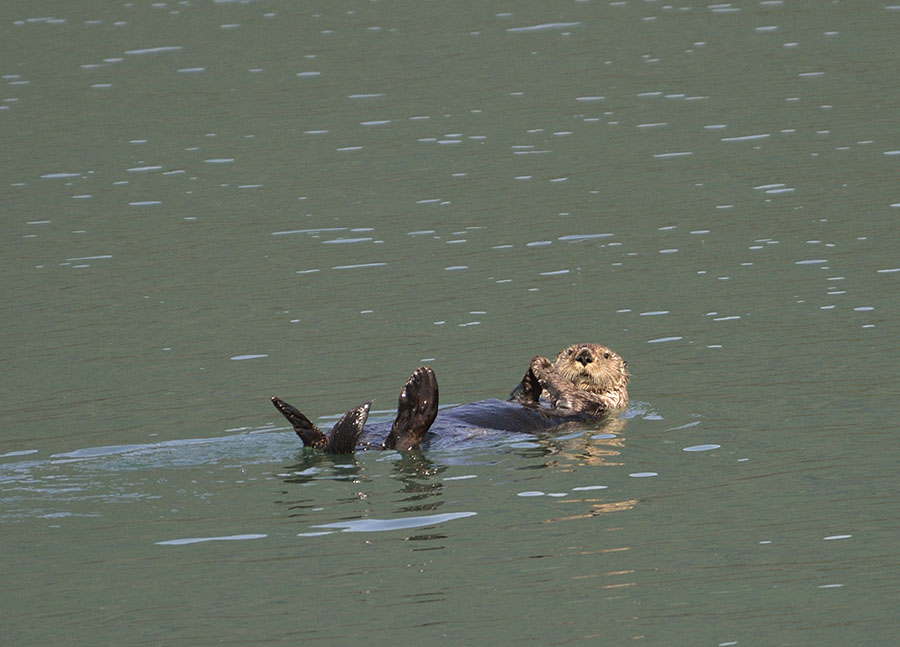 Mountain goats are another favorite of ours, and there’s a particularly good spot to look for them called Gloomy Knob. The wool from their coats is used by Native Alaskans to weave Chilkat blankets, and as a knitter I’d love to get my hands on some of their wool to play with. This year we stopped at the Knob on a hot sunny day, and some of the goats we spotted were hiding in the shade or in small caves to keep cool.
Mountain goats are another favorite of ours, and there’s a particularly good spot to look for them called Gloomy Knob. The wool from their coats is used by Native Alaskans to weave Chilkat blankets, and as a knitter I’d love to get my hands on some of their wool to play with. This year we stopped at the Knob on a hot sunny day, and some of the goats we spotted were hiding in the shade or in small caves to keep cool.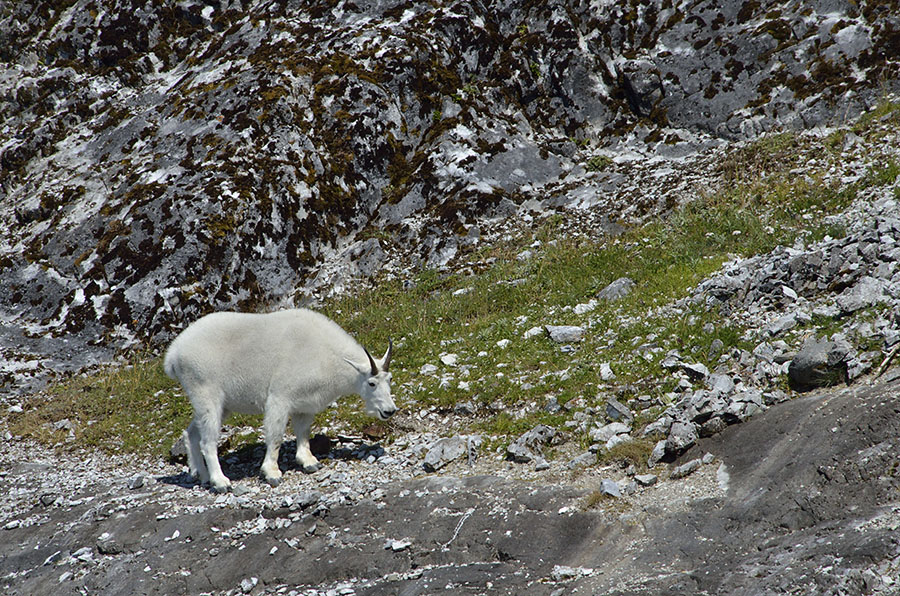 It’s amazing to watch them negotiate the steep rocks with their specialized feet and powerful muscles.
It’s amazing to watch them negotiate the steep rocks with their specialized feet and powerful muscles.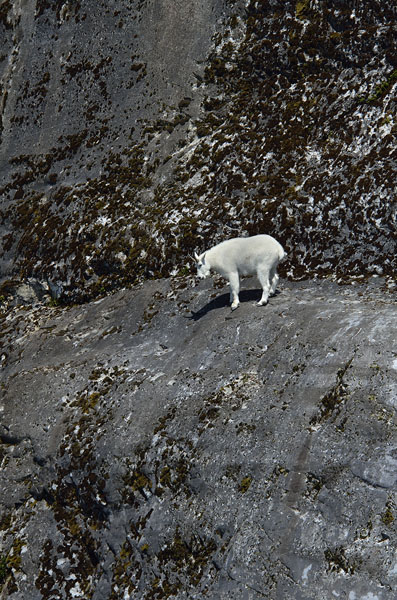 Many people come to Glacier Bay to see the glaciers, but we love it best for the wildlife. I promise the next posting will be about the ice – each glacier has its own personality, and we had good accessibility to them this season.
Many people come to Glacier Bay to see the glaciers, but we love it best for the wildlife. I promise the next posting will be about the ice – each glacier has its own personality, and we had good accessibility to them this season.